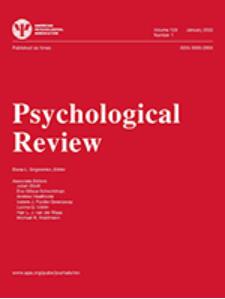Ensemble-based working memory updating and its computational rules.
IF 5.8
1区 心理学
Q1 PSYCHOLOGY
引用次数: 0
Abstract
Manipulation plays a critical role in working memory, wherein understanding how items are represented during manipulation is a fundamental question. Previous studies on manipulation have primarily assumed independent representations by default (independent hypothesis). Here, we propose the ensemble hypothesis to challenge this conventional notion, suggesting that items are represented as ensembles undergoing updating during manipulation. To test these hypotheses, we focused on working memory updating in accordance with new information by conducting three delayed-estimation tasks under addition, removal, and replacement scenarios (Study 1). A critical manipulation involved systematically manipulating the mean orientation of all memory stimuli, either increasing (clockwise) or decreasing (counterclockwise) after the updating process. Following the independent hypothesis, memory errors would be similar under both conditions. Conversely, considering the biasing effect of the ensemble on individual representations, the ensemble hypothesis predicts that memories of individual items would be updated, aligning with the ensemble's change direction. Namely, memory errors would be more positive in the increase-mean condition compared to the decrease-mean condition. Our results supported the ensemble hypothesis. Furthermore, to investigate the mechanisms underlying ensemble computations in updating scenarios, we conducted three ensemble tasks (Study 2) with similar designs to Study 1 and developed a computational model to quantify the contributions of each memory item. The results consistently demonstrated that addition involved complete updating, while removal led to incomplete updating. Across these three research parts, we propose that items are represented as dynamic ensembles during working memory updating processes. Furthermore, we elucidate the computational principles underlying ensembles throughout this process. (PsycInfo Database Record (c) 2025 APA, all rights reserved).基于集成的工作记忆更新及其计算规则。
操作在工作记忆中起着至关重要的作用,其中理解在操作过程中项目是如何表征的是一个基本问题。以往对操纵的研究主要是默认假设独立表征(独立假设)。在这里,我们提出集成假设来挑战这一传统观念,表明项目被表示为在操作过程中进行更新的集成。为了验证这些假设,我们通过在添加、移除和替换场景下进行三种延迟估计任务来关注工作记忆与新信息的更新(研究1)。关键操作包括系统地操纵所有记忆刺激的平均方向,在更新过程后增加(顺时针)或减少(逆时针)。根据独立假设,两种情况下的记忆错误是相似的。相反,考虑到整体对个体表征的偏置效应,整体假说预测单个项目的记忆将被更新,与整体的变化方向一致。也就是说,记忆错误在增加-平均条件下比减少-平均条件下更积极。我们的结果支持集合假说。此外,为了研究更新场景中集成计算的机制,我们进行了三个集成任务(研究2),其设计与研究1相似,并开发了一个计算模型来量化每个记忆项目的贡献。结果一致表明,添加涉及完全更新,而删除导致不完全更新。在这三个研究部分中,我们提出在工作记忆更新过程中,项目被表征为动态集合。此外,我们阐明了在整个过程中集成的计算原理。(PsycInfo Database Record (c) 2025 APA,版权所有)。
本文章由计算机程序翻译,如有差异,请以英文原文为准。
求助全文
约1分钟内获得全文
求助全文
来源期刊

Psychological review
医学-心理学
CiteScore
9.70
自引率
5.60%
发文量
97
期刊介绍:
Psychological Review publishes articles that make important theoretical contributions to any area of scientific psychology, including systematic evaluation of alternative theories.
 求助内容:
求助内容: 应助结果提醒方式:
应助结果提醒方式:


